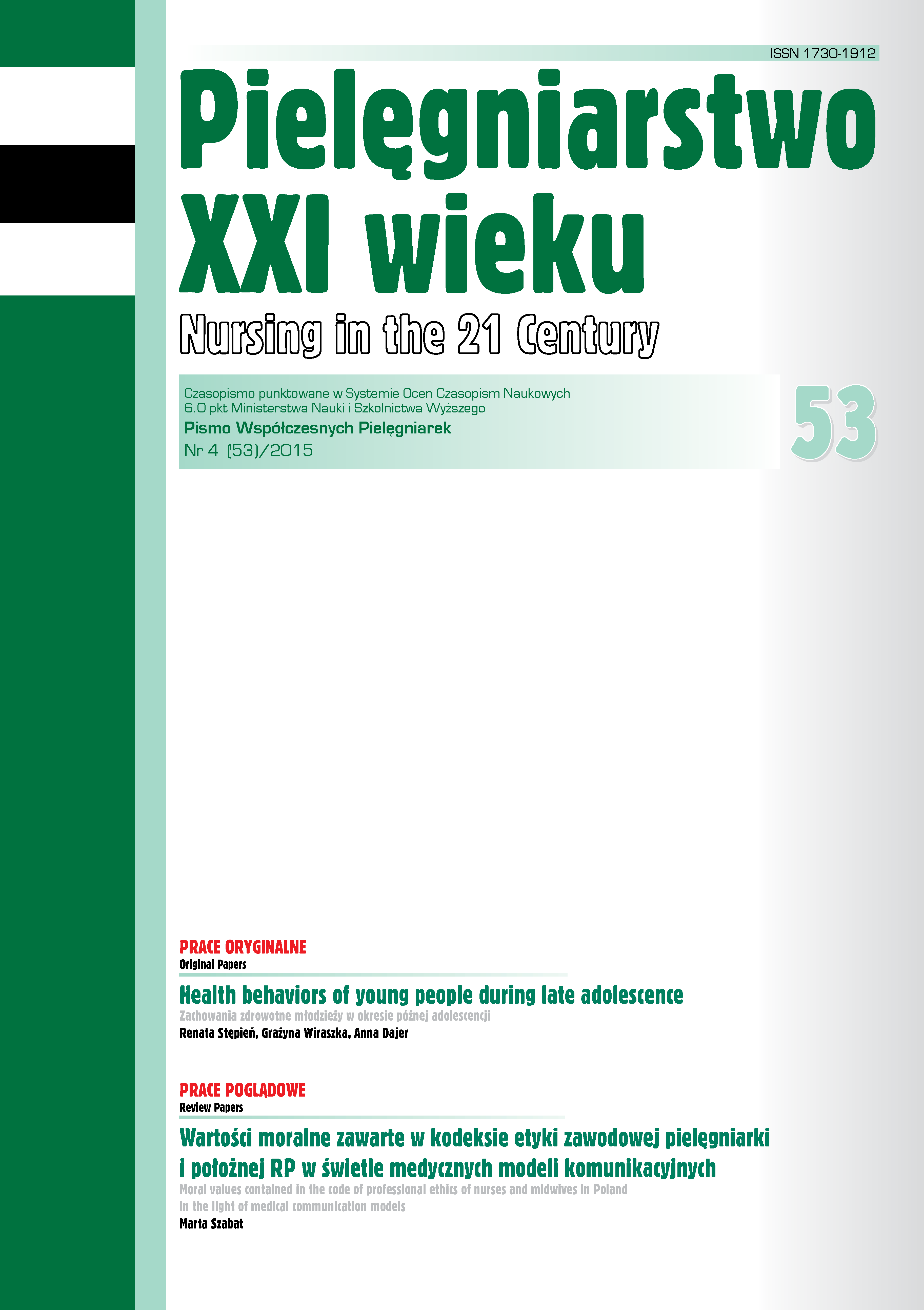A comparative analysis of job and life satisfaction of nurses working in the traditional system and in the Primary Nursing
DOI:
https://doi.org/10.12923/p21w-2015-4/45Keywords:
job satisfaction, life satisfaction, traditional nursing, Primary NursingAbstract
A COMPARATIVE ANALYSIS OF JOB AND LIFE SATISFACTION OF NURSES WORKING IN THE TRADITIONAL SYSTEM AND IN THE PRIMARY NURSING
Introduction. Professional work is not only a source of income, but also satisfaction. In Polish hospitals, the traditional care system is dominant, while the primary nursing (PN) model focused on professional activity, creativity in the field of health education, and making independent decisions in accordance with professional competence is definitely less common. Were the primary nursing system to be introduced, it would result in the following benefits: responsibility for the results of nursing care and the possibility of providing continuous care adjusted to patients’ individual needs.
Aim. The aim of this study was to compare the satisfaction of nurses who work in two different systems, primary nursing and the traditional one.
Material and methods. The study group consisted of 200 nurses employed in the traditional system and the primary nursing system. Research instruments included: the Satisfaction with Life Scale (SWLS), the Satisfaction with Work Scale (SWWS), and the authors’ questions concerning self-assessment of various aspects of work. Statistical analysis was conducted using the chisquare test with the Yates correction, and Fisher’s exact test. The level of significance was set at p < 0.05.
Results. Nurses working in the primary nursing system were significantly more satisfied with their job and more satisfied with their lives (p < 0.05). Moreover, they rated occupational status of nursing as higher (p = 0.002) and felt more independent in making patient care related decisions (p = 0.004). Difficulties combining work with private life were found in both groups and no differences between the groups were observed (p > 0.05).
Conclusion. Nurses working in the primary nursing system were more satisfied with their jobs, assessed higher their possibility of work organization.
References
1. Górajek-Joźwik J. Filozofa i teorie pielęgniarstwa. Teorie pielęgniarstwa a zindywidualizowane pielęgnowanie: proces pielęgnowania i Primary Nursing – istota i wybrane relacje. Lublin: Wyd. Czelej; 2007. s. 378-379
2. Tnoppin-Tanner S, Ojajarvi A, Vaananen A et al. Burnout as a predictor of medically certified sick-leave absences and their diagnosed causes. Behav. Med. 2005; 31(1) 18-27.
3. Diener E, Emmons RA, Larsen RJ et al. The Satisfaction With Life Scale. Journal of Personality Assessment 1985; 49, 71-75.
4. Grochans E, Seewald K, Szkup-Jabłońska M i wsp. Satysfakcja z opieki pielęgniarskiej pacjentow pielęgnowanych tradycyjnie oraz w systemie Primary Nursing, Probl. Pielęg. 2011; 19(2): 177-184.
5. Kliszcz J, Nowicka-Sauer K, Trzeciak B, i wsp. Poziom lęku, depresji i agresji u pielęgniarek, a ich satysfakcja z życia i z pracy zawodowej. Medycyna Pracy 2004; 55(6): 461-468.
6. Kunecka D. Satysfakcja pracownika a jakość usług medycznych. Probl. Hig. Epidemiol. 2010; 91 (3): 451-457.
7. Sochocka L, Wojtyłko A. Poczucie satysfakcji podopiecznych Oddziału Chirurgii Dziecięcej WCM w Opolu a model opieki funkcjonujący w oddziale. Piel. Zdr. Publ. 2011,1(1): 19-25.
8. Kędra E, Sanak K. Stres i wypalenie zawodowe w pracy pielęgniarek. Piel. Zdr. Publ. 2013, 3 (2): 119-132.
9. Sowińska K, Kretowicz K, Gaworska-Krzemińska A. i wsp. Wypalenie zawodowe i satysfakcja zawodowa w opinii pielęgniarek. Probl. Pielęg. 2012; 20 (3): 361-368.
Downloads
Published
Issue
Section
License
Copyright (c) 2015 Dorota Pilch, Mirela Sienkiewicz, Elżbieta Grochans, Marzanna Stanisławska, Daria Schneider-Matyka (Autor)

This work is licensed under a Creative Commons Attribution 4.0 International License.




